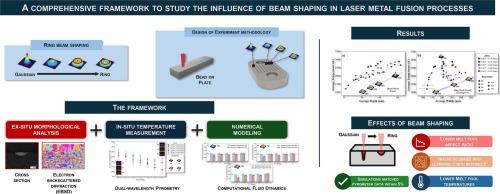研究激光金属熔合过程中光束成形影响的综合框架
IF 7.9
2区 材料科学
Q1 MATERIALS SCIENCE, MULTIDISCIPLINARY
引用次数: 0
摘要
光束整形被认为是一种能够显著提高激光金属熔合(LMF)工艺质量和稳健性的技术。但是,还需要系统地研究其对熔池动力学、温度场和微观结构的影响。在这项工作中,我们提出了一种结合计算流体动力学(CFD)模型、现场温度测量和金相分析的综合方法,以探索可编程的环梁轮廓,范围从高斯主导到环主导构型。该方法最初是在Ti-6Al-4V板上磁珠轨道上提出的,通过双波长高温计测量的过程中熔池温度与CFD预测结果进行验证,并通过金相截面进行验证。环形模式降低峰值温度达35%,将深窄池(宽高比≈0.9)转变为浅宽池(宽高比≈0.4)。这抑制了线能量≥0.28 J mm−1处的驼峰,而较低的能量只产生表面熔化。当池宽等于高温计的感应点时,模拟与高温计数据的匹配在5%以内;所有轨迹都凝固成超细α,并保留β,与光束模式无关。因此,原位、非原位和CFD工具的结合提供了一种实用的工作流程,可以帮助数据驱动的过程优化,并且可以很容易地扩展到其他LMF过程,在工业激光粉末床融合中具有潜在的实施潜力。本文章由计算机程序翻译,如有差异,请以英文原文为准。

A comprehensive framework to study the influence of beam shaping in laser metal fusion processes
Beam shaping is considered a technology capable of dramatically improving quality and robustness of Laser Metal Fusion (LMF) processes. However, systematic investigations of its effects on melt-pool dynamics, temperature field and microstructure are still required. In this work, we propose an integrated approach combining a Computational Fluid Dynamics (CFD) model, in-situ temperature measurements and metallographic analysis to explore programmable ring beam profiles, ranging from Gaussian-dominant to ring-dominant configurations. This method, initially proposed on Ti-6Al-4V bead-on-plate tracks, validates melt-pool temperatures measured in-process by a dual-wavelength pyrometer against CFD predictions, which are in turn validated with metallographic cross-sections. Ring modes lowered peak temperature by up to 35 %, transforming deep-narrow pools (aspect ratio ≈0.9) into shallow-wide ones (≈0.4). This suppressed humping at line energies ≥ 0.28 J mm−1, whereas lower energies produced only superficial melting. Simulations matched pyrometer data within 5 % whenever pool width equalled the pyrometers’ sensing spot; all tracks solidified into ultrafine α with retained β, independent of beam mode. Therefore, the combination of in-situ, ex-situ and CFD tools offers a practical workflow for assisting data-driven process optimization and can be easily extended to other LMF processes, with its potential implementation in industrial Laser Powder Bed Fusion.
求助全文
通过发布文献求助,成功后即可免费获取论文全文。
去求助
来源期刊

Materials & Design
Engineering-Mechanical Engineering
CiteScore
14.30
自引率
7.10%
发文量
1028
审稿时长
85 days
期刊介绍:
Materials and Design is a multi-disciplinary journal that publishes original research reports, review articles, and express communications. The journal focuses on studying the structure and properties of inorganic and organic materials, advancements in synthesis, processing, characterization, and testing, the design of materials and engineering systems, and their applications in technology. It aims to bring together various aspects of materials science, engineering, physics, and chemistry.
The journal explores themes ranging from materials to design and aims to reveal the connections between natural and artificial materials, as well as experiment and modeling. Manuscripts submitted to Materials and Design should contain elements of discovery and surprise, as they often contribute new insights into the architecture and function of matter.
 求助内容:
求助内容: 应助结果提醒方式:
应助结果提醒方式:


